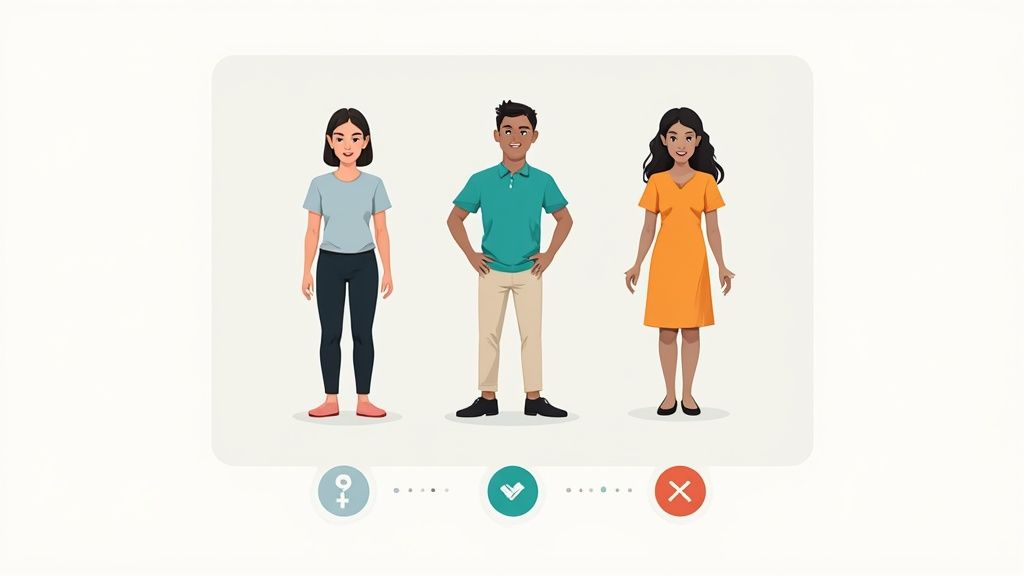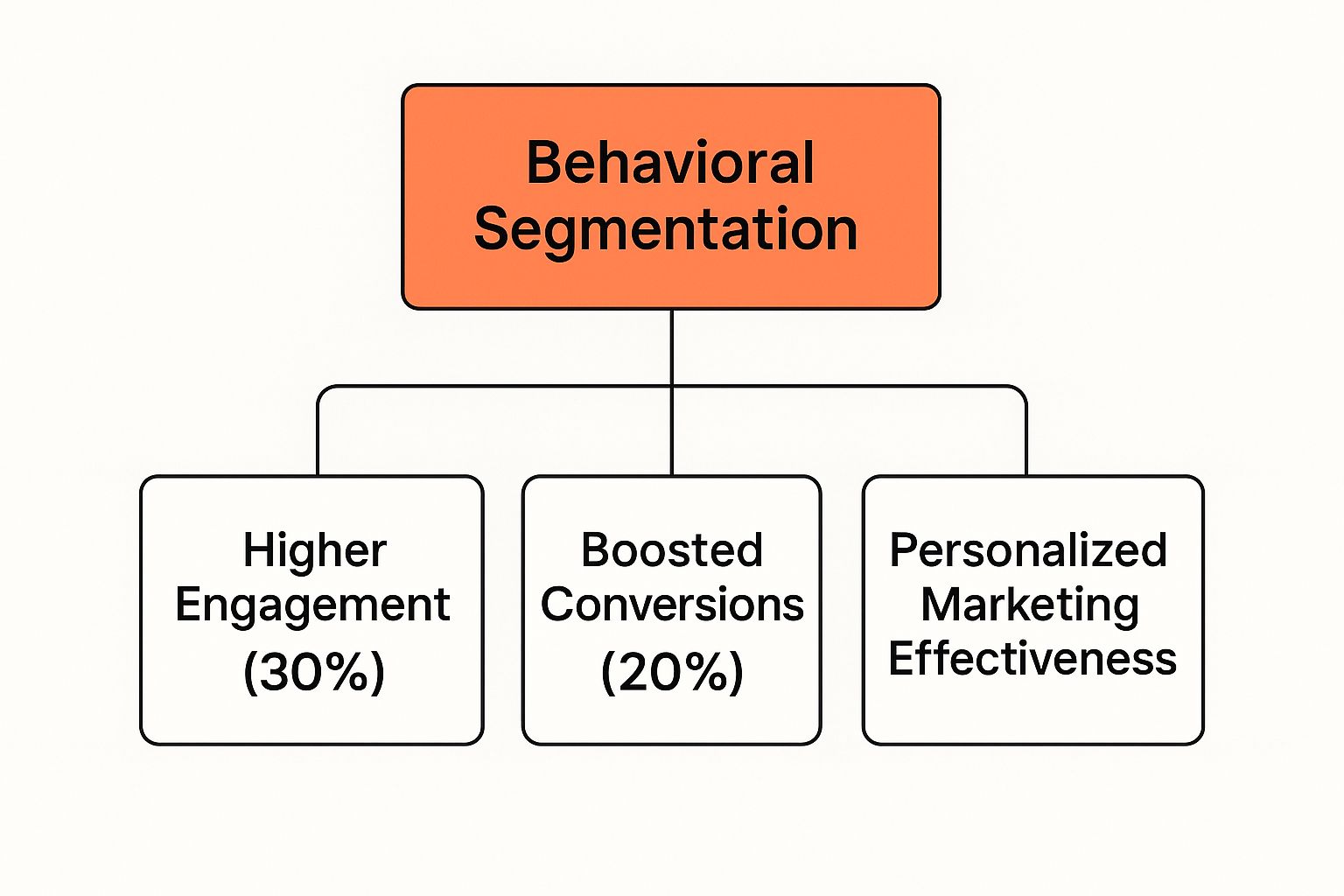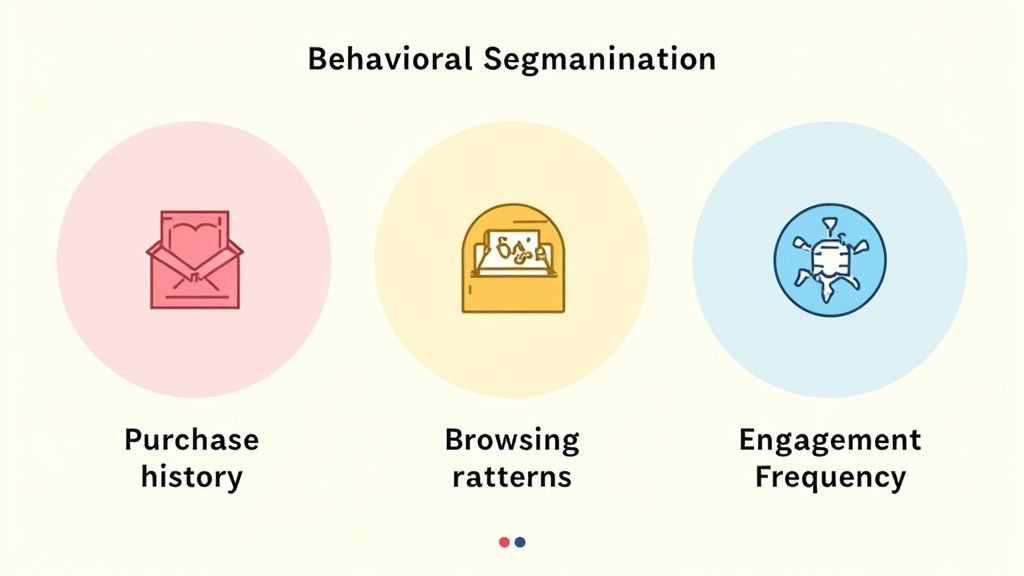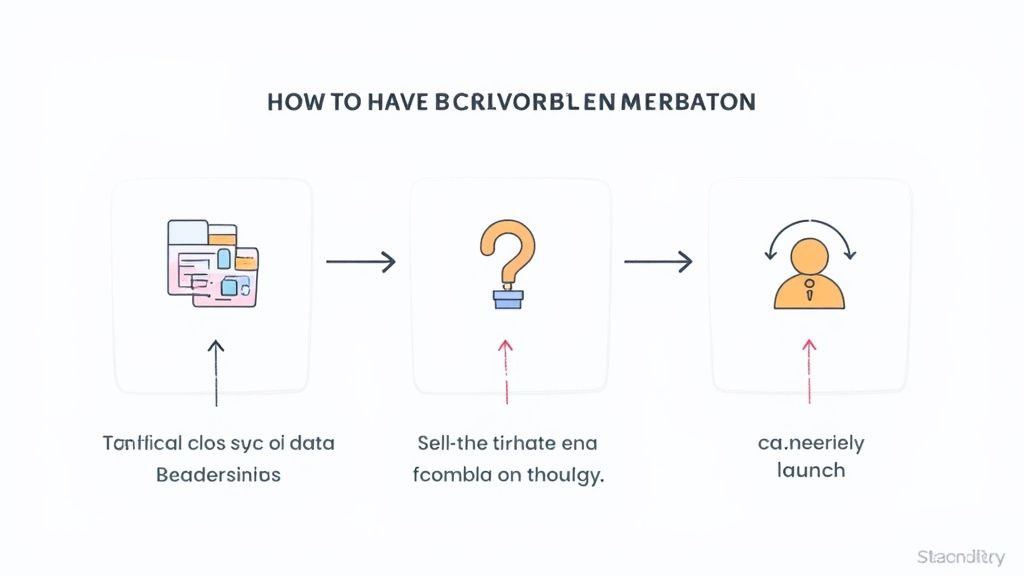What Is Behavioral Segmentation Your Complete Guide
Let's be honest, basic customer data only tells you part of the story. Knowing you have a customer who is a 35-year-old woman from California is a start, but it doesn't tell you what she actually wants or why she's on your site right now. This is where behavioral segmentation comes in, and it’s a total game-changer.
So, What Is Behavioral Segmentation, Really?

Think of it like being a personal shopper for your entire customer base. Instead of just looking at a customer's basic profile, a personal shopper pays close attention to their actions. They notice that this particular customer always buys eco-friendly products, starts looking at running shoes every March, and only pulls the trigger when there’s a free shipping offer.
That’s the core of what is behavioral segmentation. It’s about shifting your focus from who your customers are to what they actually do. It’s about understanding their habits, their interests, and their purchase triggers through their clicks, views, and past orders.
Moving Beyond Basic Demographics
This approach gives you insights that are so much richer and more actionable than static data could ever be. By tracking customer actions, you can get a real-time pulse on their intent, how engaged they are, and where they are in their buying journey.
This means you can stop guessing and start marketing with precision. Instead of blasting a generic sale announcement to your entire list, you can send a special offer for running shoes specifically to the group of customers who have been browsing them. It’s a completely different level of communication.
Behavioral segmentation allows brands to move from marketing guesswork to data-driven conversations. It’s about responding to customer actions with relevant, timely, and personalized communication that builds stronger relationships.
This shift is what creates marketing that actually connects with people. When you group customers based on their actions, you get a much clearer picture of what truly motivates them. And the impact on your bottom line is huge. Targeted email campaigns based on behavior can drive 58% of all marketing revenue, and some marketers have seen revenue from segmented campaigns jump by as much as 760%. You can dig into more of this powerful data in research from Amplitude.
Ultimately, this data-driven approach helps you build a customer journey that feels helpful and intuitive. You're no longer just selling; you're guiding shoppers toward what they really want, building the kind of brand loyalty that lasts.
The Four Core Types of Behavioral Segmentation
To really understand your customers, you have to look at what they do. Behavioral segmentation isn't some complex, abstract theory; it's a practical way of grouping people based on their real-world actions. Think of it as having four different lenses to view your audience through. Each lens shows you a different aspect of their relationship with your brand.
By understanding these four core types, you can move beyond simple demographics and get to the heart of why people are clicking, browsing, and buying on your site.
Purchase Behavior
This is the most direct and, frankly, one of the most powerful ways to segment your audience. It’s all about grouping customers based on their buying patterns. Are they brand new to your store and need a warm welcome? Or are they a seasoned regular who's bought from you 10 times and deserves the VIP treatment?
Looking at purchasing behavior helps answer some critical questions:
- Who are my one-and-done buyers versus my loyal repeat customers?
- Which shoppers are always grabbing the high-ticket items, and who only buys during a sale?
- Who consistently loads up their cart only to leave it behind?
A Shopify store, for instance, could create a "Recent First-Time Buyers" group and send them a helpful email with tips on using their new product. At the same time, their "VIP Spenders" segment could get an exclusive first look at an upcoming collection. It’s about meeting people where they are in their buying journey.
Usage Behavior
This type of segmentation zooms in on how and how often customers interact with your store or products. It’s not just about whether they buy, but about their level of engagement. Are they browsing every week, or do they only show up once a year? This is key to identifying your biggest fans and, just as importantly, those who are about to drift away.
Usage behavior helps you see the difference between:
- Power Users: These are the people who are on your site constantly, maybe even daily.
- Occasional Users: Shoppers who tend to visit only during big sales like Black Friday.
- Dormant Users: Customers who haven't stopped by or made a purchase in 90 days or more.
With this knowledge, a store could send a "We Miss You!" discount to its dormant users to spark their interest again. On the flip side, they could give their power users bonus loyalty points to thank them for their consistent business. For a closer look at these kinds of strategies in action, check out these insightful customer segmentation examples.
Occasion-Based Behavior
This one is all about timing. It groups customers based on specific events or moments that trigger a purchase. These can be big, universal holidays like Valentine's Day, or they can be deeply personal moments like a birthday or an anniversary.
Occasion-based segmentation is about connecting with customers in the moments that matter most to them. It’s about showing up with the right message at the perfect time, making your product feel incredibly relevant.
A gift shop could build a segment of everyone who bought something around Mother's Day last year and send them a gentle reminder campaign a few weeks ahead of time. Or, a subscription box service could target customers whose subscriptions are about to expire, positioning the renewal as a perfectly timed "treat yourself" opportunity.
The image below shows just how powerful this kind of targeted approach can be for driving real results.

As you can see, personalization fueled by smart segmentation isn't just a nice-to-have; it directly leads to better engagement and more sales.
Benefits Sought
Finally, we get to the core of customer motivation. This type of segmentation groups people based on the specific value or benefit they’re looking for in your product. Not everyone is buying your skincare for the same reason—some want anti-aging, others want hydration. Understanding this lets you tailor your message to their exact needs.
Common benefits customers seek include:
- Price Sensitivity: They’re hunting for the best possible deal.
- Quality Focus: They’re willing to pay more for premium materials, craftsmanship, or features.
- Convenience: They prioritize things like fast shipping and hassle-free returns above all else.
An electronics store could send a "Clearance Sale" email to its price-sensitive segment. In the very same week, it could promote a new, high-end gadget to its quality-focused segment, using language that highlights superior performance and durability. It’s the same store, but two very different conversations.
To pull this all together, here’s a quick overview of these four key types of behavioral segmentation.
Key Types of Behavioral Segmentation
| Segmentation Type | What It Tracks | E-commerce Example |
|---|---|---|
| Purchase Behavior | Buying habits, purchase frequency, and average order value. | Creating a "VIP" segment for customers who have spent over $500 in the last year. |
| Usage Behavior | How often customers visit your site, browse products, or use features. | Sending a re-engagement offer to users who haven't logged in for 90 days. |
| Occasion-Based Behavior | Purchases tied to specific holidays, events, or personal moments. | Targeting past Valentine's Day shoppers with a "Find the Perfect Gift" campaign in early February. |
| Benefits Sought | The primary value or need a customer is trying to fulfill. | Promoting free, next-day shipping to a segment that prioritizes convenience and speed. |
Each of these approaches gives you a unique window into your customers' world, helping you craft marketing that feels less like a generic broadcast and more like a helpful, one-on-one conversation.
Why Behavioral Segmentation Is a Game-Changer for E-commerce

It’s one thing to know what behavioral segmentation is, but the real magic happens when you see what it can do for your store's bottom line. This isn't just about shuffling customers into neat little boxes. It's about drawing a straight line from their actions to your business outcomes, turning raw data into real revenue.
When you shift your focus from who your customers are to what they do, you open up a whole new world of personalization. Suddenly, you can send the right message to the right person at exactly the right time. In today’s crowded e-commerce space, that’s how you stand out.
Drive Engagement and Build Real Loyalty
Personalization fueled by behavioral data makes your customers feel like you actually get them. Imagine a shopper receiving an offer for the exact pair of sneakers they were just eyeing, instead of a generic "20% off everything" email blast. That's relevance. And that’s what gets people to open your emails, click your ads, and keep coming back.
Over time, these consistently positive, relevant interactions build genuine brand loyalty. People stick with brands that understand their needs. By meeting them where they are, you start turning one-time buyers into repeat customers and, eventually, into loyal fans who trust what you have to say.
Fine-Tune Your Ad Spend and Boost Conversions
One of the fastest ways to drain a marketing budget is to show your ads to people who simply don't care. Behavioral segmentation helps you stop guessing. It lets you laser-focus your ad spend on segments with clear intent, like shoppers who left something in their cart or visitors who keep coming back but haven't pulled the trigger yet.
When you target people based on their recent actions, you ensure your marketing dollars are working as hard as they can, reaching audiences that are much closer to making a purchase. The result is a better return on ad spend (ROAS) and a more efficient way to win new customers.
This targeted approach naturally lifts conversion rates. By creating specific customer journeys for each segment, you can smooth out the path to purchase and gently guide them toward the checkout. It's no surprise that the global market for behavioral targeting was valued at USD 10.5 billion and is expected to hit nearly USD 29.8 billion, according to research from DataIntelo. This explosive growth shows just how much brands are investing in this kind of smart, personalized marketing.
Increase Customer Retention and Lifetime Value
We all know it costs more to acquire a new customer than to keep an existing one. Think of behavioral segmentation as your early-warning system for at-risk customers. By monitoring how often someone shops or engages with your brand, you can spot when their interest is fading. That's your cue to step in with a thoughtful offer or helpful content to bring them back into the fold before they're gone for good.
In the end, all these benefits—better engagement, smarter spending, and stronger retention—all lead to a higher customer lifetime value (LTV). By delivering relevant experiences time and time again, you give customers more reasons to shop with you more often, and for a lot longer. For more on this, don't miss our guide on how to improve customer retention in e-commerce.
See Behavioral Segmentation in the Wild

Knowing the theory is great, but seeing behavioral segmentation in action is where it all clicks. The world’s biggest brands have built empires by understanding and reacting to what their customers do. They’ve perfected the art of creating experiences that feel less like marketing and more like a helpful conversation, making you wonder, "How did they know I wanted that?"
This isn’t magic; it's a smart, data-driven strategy. By looking at how these giants operate, you can see the clear line they draw from tracking a simple action, to creating a customer segment, to earning incredible loyalty. Each example is a masterclass in turning behavior into a powerful, personal experience that keeps people coming back.
Amazon’s Predictive Recommendation Engine
Amazon is the undisputed master of using purchase and browsing behavior at an unbelievable scale. Every click, search, and purchase you make feeds its powerful recommendation engine. The system doesn't just look at what you bought; it analyzes what you viewed but didn't buy, what you added to your cart, and even how long you spent looking at a product page.
- Behavior Tracked: Purchase history, product views, search queries, and items added to wish lists.
- Segment Created: Groups of users with similar buying and browsing patterns (e.g., "customers who bought this also bought...").
- Personalized Experience: The famous "Recommended for you" and "Frequently bought together" sections that drive a huge chunk of their sales.
This constant analysis lets Amazon predict what you might need next, sometimes even before you realize it yourself.
Netflix and the Art of Content Curation
Netflix’s entire business model depends on keeping you subscribed, and its secret weapon is usage-based segmentation. The platform tracks everything: what you watch, how long you watch it, what you quit halfway through, and what you add to your list. It even pays attention to the time of day you prefer certain genres.
Netflix doesn’t just show you what’s popular; it shows you what’s popular with people like you. This distinction is the core of its personalization strategy, turning a massive content library into a manageable, enticing experience for each user.
By creating thousands of tiny segments based on viewing habits, Netflix can personalize everything from your homepage layout to the specific thumbnail you see for a movie. Someone who watches a lot of comedies might see a funny image for a drama, while a thriller fan sees a more suspenseful one for the very same title.
Spotify’s Data-Driven Playlists
Spotify has perfected the art of using listening behavior to build deep user loyalty. Its legendary "Discover Weekly" and "Release Radar" playlists are the direct result of smart segmentation. The platform analyzes your listening history, skipped songs, and personal playlists to get an almost psychic read on your musical taste.
- Behavior Tracked: Listening history, skipped tracks, liked songs, and playlist additions.
- Segment Created: Users with similar listening profiles and genre preferences.
- Personalized Experience: Custom playlists delivered weekly that feel like a mixtape made by a friend who knows you perfectly.
This approach turns a simple streaming service into a personal music discovery tool. You can also see this in action through advanced marketing techniques like programmatic advertising, which delivers specific ads based on user behavior across the web. All of these strategies prove that understanding actions is the key to smarter, more relevant communication.
Putting Behavioral Segmentation to Work on Your Store
Knowing the theory is great, but putting it into practice is what actually grows your business. Think of this as your playbook for making behavioral segmentation a reality on your e-commerce store. We’ll break down this big idea into clear, manageable steps you can start taking today.
It all starts with a simple question, and it's not about data: What are you trying to achieve? Your goals are your compass here, guiding every decision. Are you trying to slash your cart abandonment rate? Or is your main focus getting existing customers to come back and buy again?
Once you have a clear objective, you can figure out which data points actually matter. Don't fall into the trap of tracking everything. Zero in on the behaviors directly tied to your goal—things like how often someone buys, which specific products they look at, or how they interact with your email campaigns.
Choosing Your Tools and Defining Segments
With your goals set and your key data points identified, it's time to pick the right tools for the job. While many e-commerce platforms offer some built-in analytics, specialized apps like Toki can put much of this work on autopilot. This makes it so much easier to create dynamic, rule-based segments that stay updated in real time.
Now for the fun part: building out your first segments. Start simple and focus on the groups that can make a real impact.
- Lapsed Customers: Anyone who hasn't made a purchase in over 90 days.
- High-Value Shoppers: Your top 10% of customers, ranked by their total spending.
- Window Shoppers: Visitors who have checked out a specific product more than three times but still haven't bought it.
- Recent First-Time Buyers: New customers who made their first purchase within the last 30 days.
By grouping customers this way, you can create a clear roadmap for how to build client loyalty and start turning casual browsers into your biggest fans.
Launching Targeted Campaigns
This is where your strategy truly comes to life. With your segments ready, you can craft campaigns that speak directly to what each group is doing. For those lapsed customers, a friendly "We Miss You" email with a small discount can work wonders. For your high-value shoppers, you might offer exclusive early access to a new product drop, making them feel like the VIPs they are.
This kind of specific, relevant marketing isn't just a nice-to-have anymore; it's essential. The global behavior analytics market was valued at USD 1.10 billion and is expected to soar to USD 10.80 billion. This massive jump shows just how critical it is for brands to understand the 'why' behind customer actions to stay ahead.
Every targeted campaign is a chance to act on these insights and improve customer engagement. Following this process turns raw data into meaningful conversations and, most importantly, into real results for your store.
Answering Your Top Questions
Getting into a new strategy like behavioral segmentation always brings up a few questions, even when you have a solid plan. That's perfectly normal. Let's tackle some of the most common ones so you can feel confident moving forward.
Lots of merchants ask how this is really any different from the marketing they’re already doing. It's a great question, and the answer comes down to one key difference: separating static facts from dynamic actions.
How Is This Different from Demographic Segmentation?
Think of it like this: demographic segmentation tells you who your customers are. Behavioral segmentation tells you what they want right now.
- Demographics are the fixed labels. They describe a customer using static info like age, gender, or location. A 30-year-old man in New York is, well, always a 30-year-old man in New York.
- Behaviors are all about action. They show you a customer's current intent, interest, and engagement level by tracking what they click on, what they buy, and how they browse. That same man could be a "casual browser" one week and a "first-time buyer" the next.
Demographics give you a snapshot, but behaviors give you the story. One tells you what a customer is, while the other shows you what they are becoming—which makes your marketing far more timely and relevant.
While demographics are great for sketching out your general audience, behavior is what lets you connect with them in the moment. According to McKinsey, a staggering 71% of consumers now expect personalized interactions. That’s something you can deliver far more effectively with actions, not just attributes.
What Tools Do I Really Need to Start?
You don't need a massive, expensive tech stack to get started with behavioral segmentation. Most e-commerce platforms, including Shopify, already have built-in analytics and customer list features that work as a great launchpad. You can start right now by manually creating segments based on purchase history or last visit date.
But when you're ready to automate and scale up, you’ll want to look at a few specialized tools.
- Email Marketing Platforms: Many modern email services let you tag and segment subscribers based on what they do on your site, like clicking a link in a campaign or viewing a specific product category.
- Customer Data Platforms (CDPs): These tools are built to pull customer data from all your different sources into one unified profile, giving you a complete picture of their behavior.
- Specialized Loyalty Apps: Platforms like Toki are designed to not only track behavior but also to act on it. They can automate rewards, points, and targeted campaigns, simplifying the whole process from insight to action.
The key is to begin with the tools you already have and then layer in more powerful ones as your strategy gets more ambitious.
Is This Too Complicated for a Small Business?
Not at all. This is probably the biggest myth about behavioral segmentation. You don’t need to juggle dozens of complex segments to see a real impact. The best part about this strategy is that it’s completely scalable.
For a small business, the smartest way in is to pick one or two high-impact segments that tie directly to a major business goal.
- Your Goal: Reduce cart abandonment. Your Segment: Create a group of shoppers who added an item to their cart in the last 24 hours but didn’t check out.
- Your Goal: Get more repeat purchases. Your Segment: Build a list of first-time buyers who made a purchase 30 days ago, and send them a "we miss you" offer.
By focusing on these simple, high-value groups first, you can get meaningful results without feeling overwhelmed. You can prove the concept works, see the return on your time, and then gradually build out more segments as you get the hang of it. It’s all about starting small to win big.
Ready to turn customer actions into loyal fans? Toki makes it easy to create powerful behavioral segments, from rewarding your top spenders to re-engaging at-risk customers. Start building stronger relationships today.